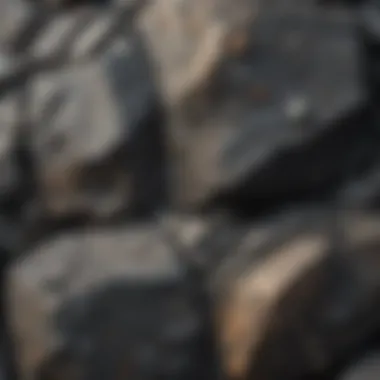How to Identify Igneous Rocks: A Complete Guide


Intro
Understanding igneous rocks is fundamental for rock and fossil collectors. These rocks, formed from the cooling and solidification of magma or lava, hold invaluable insights into the Earth's geological history. This guide aims to demystify the identification process for igneous rocks, offering practical strategies and showcasing their unique characteristics.
Topic Overview
Definition of Igneous Rock
Igneous rocks are classified as one of the three main types of rocks, alongside sedimentary and metamorphic rocks. They originate from molten material, known as magma, which crystallizes and solidifies. Depending on where this process occurs, igneous rocks can be further categorized into intrusive and extrusive types. Intrusive igneous rocks, such as granite, form below the Earth's surface, while extrusive types, like basalt, solidify on the surface after a volcanic eruption.
Brief History and Significance
The study of igneous rocks dates back centuries. They have played a vital role in our understanding of the Earth's structure. Early geologists recognized the importance of these rocks in mapping geological processes. Observations of volcanic activity revealed how these rocks contribute to the landscape and climate. Today, igneous rocks continue to provide insight into tectonic movements and the history of our planet.
Identification and Classification
How to Categorize Igneous Rocks
Identifying igneous rocks involves analyzing their texture, mineral composition, and origin. Here are the key categories:
- Intrusive Igneous Rocks
- Extrusive Igneous Rocks
- Granite
- Diorite
- Gabbro
- Basalt
- Pumice
- Obsidian
The texture varies significantly between these types due to where they evolve. Intrusive types cool slowly, resulting in coarse-grained textures, while extrusive types cool quickly, leading to fine-grained structures.
Tips for Identifying Key Features
When identifying igneous rocks, consider the following features:
- Texture: Observe whether the rock appears coarse or fine-grained.
- Mineral Composition: Identify the minerals present. Common minerals include quartz, feldspar, and biotite.
- Color: Note the color which can range from light to dark shades, depending on mineral content.
- Luster: Check if the surface is shiny or dull, which can give clues about the minerals.
Each characteristic acts as a piece of the puzzle, guiding collectors to accurately classify and appreciate these geological wonders.
Preamble to Igneous Rocks
Understanding igneous rocks is crucial for anyone keen on geology. These rocks form from cooled magma or lava and provide insights into the processes that shape our planet. They are not just mere formations; their study reveals significant geological history and evolution. This section provides the necessary grounding to identify igneous rocks effectively. By comprehending their key characteristics, you can appreciate their role in the Earth's crust.
Definition and Importance
Igneous rocks are formed through the cooling and solidification of molten material known as magma. This process can occur below the Earth's surface as intrusive igneous rocks or above the surface as extrusive ones. Their formation is not just a geological occurrence but marks the beginning of many rock cycles. This cycle plays a vital role in nutrient recycling, landscape formation, and even human utilization of resources. Understanding what igneous rocks are helps in identifying them in the field, which is essential for rock collectors or students of geology. Recognizing different types can lead to deeper insights into their formation conditions and the environment of their origin.
The Role of Igneous Rocks in Earth's Geology
Igneous rocks hold a prominent place in the study of Earth's geology. They make up a significant portion of the Earth's crust and play a part in its structural composition. Understanding these rocks helps in grasping concepts such as plate tectonics, volcanic activity, and the Earth's thermal history. For instance, granite and basalt not only showcase different cooling rates but also highlight the diversity that exists within this rock category. Collecting and studying these types can be instrumental for enthusiasts to connect with Earth’s geological timeline. Furthermore, igneous rocks influence soils and ecosystems, making them an integral aspect of both geology and environmental science. They are also valuable resources for various industries, from construction to manufacturing.
"Igneous rocks are the foundation upon which Earth's geological processes build. Understanding them offers insights into our planet's past and future."


The Formation of Igneous Rocks
Understanding the formation of igneous rocks is essential for identifying and classifying them effectively. These rocks form from the solidification of molten material, known as magma when below the surface and lava when it reaches the Earth’s surface. This process is fundamental to the rock cycle, influencing both the composition of the Earth’s crust and the formation of various geological features. By grasping the intricacies of how igneous rocks are formed, collectors and geologists can better interpret the history of an area, discover patterns in rock distribution, and recognize the unique characteristics of different igneous rock types.
Magmatic Processes
Magmatic processes refer to the series of events that lead to the formation of magma and, ultimately, igneous rocks. The formation begins deep within the Earth, where high temperatures and pressures cause the melting of pre-existing rocks. This molten rock then accumulates in magma chambers.
The composition of the magma largely determines the type of igneous rock that will form. There are several factors influencing this process, including:
- Temperature: Higher temperatures result in more liquid magma, which allows for easier movement.
- Pressure: Greater pressure can lead to more complex chemical interactions in the magma.
- Composition: Different minerals melt at different temperatures, leading to varied magma compositions.
These factors interact in complex ways, ultimately producing diverse types of igneous rocks. Understanding these processes provides insight into not just the rocks themselves, but also the behaviors of the Earth under various geological conditions.
Intrusions and Extrusions
Igneous rocks are categorized based on where they solidify. Intrusions occur when magma cools and solidifies beneath the Earth’s surface. This process results in rocks with larger crystals such as granite. The slower cooling allows for more time for crystals to grow. On the other hand, extrusions occur when lava erupts onto the surface and cools rapidly, forming rocks like basalt. These cooling rates are critical in distinguishing between the two types. To summarize:
- Intrusive Igneous Rocks: Form from magma cooling slowly underground. E.g., Granite.
- Extrusive Igneous Rocks: Form from lava cooling quickly on the surface. E.g., Basalt.
Each type provides different physical characteristics, which can also reflect the environment of formation and the geological history of the region.
Cooling Rates and Crystal Size
The cooling rate of magma or lava significantly affects the texture and size of the resulting crystals in igneous rocks.
When magma cools slowly, as in the case with intrusive igneous rocks, larger crystals develop. Conversely, fast cooling results in smaller crystals, often creating a glassy texture in extrusive rocks.
Here are key points to consider:
- Slow Cooling: Allows larger crystals to form. These are visible to the naked eye and indicate an intrusive origin.
- Rapid Cooling: Results in fine-grained textures. In extreme cases, this can lead to volcanic glass.
The relationship between cooling rates and crystal sizes is pivotal in rock identification. When examining igneous rocks, noting the size of grains can reveal important insights into their formation and history.
Physical Characteristics of Igneous Rocks
Understanding the physical characteristics of igneous rocks is crucial for accurate identification. These traits help distinguish igneous rocks from other types, such as sedimentary and metamorphic. By examining color, texture, and mineral composition, collectors and geologists can deduce the rock's origin and the conditions under which it formed. Each physical attribute serves as a clue, guiding observers towards a comprehensive analysis.
Color Variations
Color plays a significant role in identifying igneous rocks. The hue of a rock often indicates its mineral components. For example, rocks rich in feldspar may appear light-colored, while basalt, high in iron and magnesium, usually exhibits dark shades.
When you look at various igneous rocks, notice the differences in color:
- Granite typically displays a lighter color, often pink or grey.
- Basalt appears in darker tones, commonly black or dark grey.
- Obsidian is glassy and can be black or even brown.
Analyzing color helps narrow down the possibilities when identifying an igneous rock. However, one must remember that weathering and other environmental factors can alter a rock's appearance over time.
Texture: A Key Indicator
Texture is another salient characteristic when identifying igneous rocks. Texture is determined primarily by crystal size and arrangement, which reflects the cooling process of the molten material. The two main categories of igneous rock textures are:
- Intrusive (Plutonic): These rocks form when magma cools slowly beneath Earth's surface. Granites are a prime example, typically showing large, well-formed crystals due to the prolonged cooling time.
- Extrusive (Volcanic): These rocks form when lava cools quickly on the surface. As a result, they often have a fine-grained texture, such as in basalt.
Moreover, certain textures indicate further complexities, such as:
- Porphyritic: A mix of large crystals embedded in a finer matrix, suggesting a two-stage cooling process.
- Vesicular: Contains gas bubbles, often seen in pumice, indicating rapid cooling.


Mineral Composition
The mineral composition of igneous rocks is vital for classification and understanding their formation. Common minerals in igneous rocks include:
- Feldspar: One of the most abundant minerals, contributing to lighter-colored rocks.
- Quartz: Usually found in granitic rocks, it adds to a rock's durability.
- Mica: Present in some granites and schists, it affects both texture and appearance.
- Olivine and Pyroxene: Common in darker rocks like basalt, these minerals indicate higher temperatures in the rock formation process.
Utilizing tools like hand lenses or polarized light microscopes can aid in identifying these minerals. A well-rounded knowledge of mineral composition enhances one’s ability to classify igneous rocks and understand the geological history behind them.
Distinguishing Igneous Rocks from Other Types
Identifying igneous rocks is an essential part of geology. Understanding the distinctive traits of igneous rocks helps to differentiate them from other rock types, such as sedimentary and metamorphic. This knowledge is particularly crucial in fields like geology, archaeology, and environmental science. Each rock type has unique features that can be observed through systematic examination. Thus, recognizing these key differences fosters a deeper appreciation for rock classification and the processes that formed them.
Comparing with Sedimentary Rocks
Sedimentary rocks are formed by the accumulation of sediments. These can come from the erosion of pre-existing rocks or from biological activity. Contrary to igneous rocks, which crystallize from molten magma, sedimentary rocks often exhibit layers and may contain fossils. A significant feature is their often lighter color and fine texture, due to the compacted sediments that make up their structure.
Key Features of Sedimentary Rocks:
- Layering: They usually show distinct layers or strata.
- Fossils: Many sedimentary rocks contain fossils, providing evidence of past life.
- Grain Size: They often have a finer grain size compared to igneous rocks.
- Composition: They can be rich in organic material such as carbonates and shales.
When comparing both rock types, look for the characteristics that underline their formation processes. Igneous rocks often have a more granular texture, which is a result of rapid cooling and crystallization. Examining the surface and breaking patterns can also aid in identification.
Differentiating from Metamorphic Rocks
Metamorphic rocks are formed from existing rocks that undergo a transformation due to heat and pressure. This process alters their mineral composition and structure. Unlike igneous rocks, metamorphic rocks may exhibit foliation—a layered appearance resulting from the alignment of minerals. This is a critical factor in their differentiation.
Common Characteristics of Metamorphic Rocks:
- Foliation: Look for the layered or banded appearance.
- Texture: May appear glossy or schistose due to mineral alignment.
- Durability: Metamorphic rocks tend to be harder due to their formation process.
- Parent Rocks: Typically derived from sedimentary or igneous sources, they maintain their core minerals while transforming.
In summary, recognizing the differences between igneous, sedimentary, and metamorphic rocks enhances observational skills. Each rock type tells a unique geological story. Observing texture, layering, and mineral composition are critical in identifying and classifying these rocks accurately. With practice, one can reliably distinguish igneous rocks from their counterparts.
Practical Methods for Identifying Igneous Rocks
In the field of geology, practical methods for identifying igneous rocks are invaluable. These methods allow enthusiasts and professionals alike to distinguish between rock types effectively. Understanding igneous rocks is essential not only for academic purposes but also for applications in construction, landscaping, and education. With a hands-on approach, one can gain insights into the Earth's processes and the materials that compose it.
Field Examination Techniques
Field examination techniques are often the first step in identifying igneous rocks. These techniques rely on direct observation and interaction with the rock samples. First, note the color and texture of the rock. Igneous rocks can vary from light to dark hues based on their mineral composition. For instance, granite typically exhibits a lighter color with visible crystals, while basalt usually presents a darker and finer-grained appearance.
Next, consider the rock's texture. Igneous rocks can be classified as coarse-grained, fine-grained, or glassy. Coarse-grained rocks like granite have larger crystals because they cooled slowly beneath Earth's surface. In contrast, fine-grained rocks such as basalt cooled more rapidly, resulting in smaller crystals. Glassy textures, as seen in obsidian, occur when lava cools so fast that crystals do not have time to form.
Another practical technique is to perform a scratch test. Use a steel nail to scratch the rock surface. The hardness can indicate its mineral content. For example, a rock that scratches easily may contain softer minerals, while a harder rock will resist scratching. This simple yet effective method can help narrow down the type of igneous rock in question.
Laboratory Analysis Methods
For those unable to determine the rock type through field techniques, laboratory analysis methods offer a more sophisticated approach. One common method is thin section petrography, where a small slice of rock is mounted on a glass slide and examined under a microscope. This technique allows for the observation of mineral characteristics and their relationships, providing valuable information about the rock's origin and formation process.
Chemical analysis is another laboratory method used to identify igneous rocks. Tools such as X-ray fluorescence (XRF) can determine the elemental composition of the rock. Identifying the abundance of certain elements, like silicon, aluminum, and iron, can effectively classify igneous rocks further. This information is crucial for understanding the rock's behavior and potential applications.
Using Geological Maps and Resources


Utilizing geological maps and resources can enhance the identification process. Geological maps often indicate the rock types present in specific areas, along with their distribution and geological age. These maps serve as an essential tool during field visits, guiding collectors and geologists to areas where certain igneous rocks are likely to be found.
Online resources, such as the Geological Society of America or regional geological surveys, provide access to invaluable data. These sources can help to correlate specific rock formations with igneous types, informing rock collectors of the features they should look for when visiting various geological sites.
Additionally, engaging with communities on platforms like Reddit can also provide insights and knowledge sharing among rock collectors. Here, enthusiasts can discuss identification techniques and share findings based on their own experiences.
"Understanding practical methods of rock identification can significantly enhance your confidence and skills in geology."
In summary, combining field examination techniques, laboratory analysis methods, and the use of geological maps creates a comprehensive approach for identifying igneous rocks.
Common Igneous Rock Types
Understanding common igneous rock types is fundamental in the study of geology. Igneous rocks, formed from the solidification of molten magma, exhibit diverse characteristics that can reveal much about their formation and the environment in which they were created. This section will delve into three significant types of igneous rocks: granite, basalt, and the unique glassy forms of obsidian and pumice. Each rock type has distinct features, uses, and roles in both natural ecosystems and human applications.
Granite: Characteristics and Uses
Granite is one of the most abundant and well-known igneous rocks. It is primarily composed of quartz, feldspar, and mica, giving it a distinctive speckled appearance. Granite's durability makes it highly sought after in construction and architecture. It is often used for countertops, flooring, and monuments. The rock's ability to withstand weathering and pressure adds to its popularity.
In geology, granite can tell a lot about the Earth's crust. Its formation occurs deep within the Earth, where it cools slowly, allowing large crystals to develop. Recognizing granite involves observing its light color and grainy texture. Variations occur, leading to types like biotite granite, which includes dark mica and modifies the typical color palette.
Basalt: Origin and Significance
Basalt is another prevalent igneous rock but differs markedly from granite. It is dark in color and relatively fine-grained, forming from the rapid cooling of lava at the Earth's surface. This process leads to the formation of small crystals, which gives basalt its smooth texture. Basalt covers about 70% of the Earth’s surface, especially in oceanic regions, making it essential in understanding plate tectonics and volcanic activity.
The rock's significance extends beyond geology. It is commonly used in construction, as aggregate for concrete, and in road building. Basalt is also vital in landscaping and gardening, favored for its aesthetic appeal. In examining basalt, look for its dense, heavy nature and distinctive dark color, which differentiates it from lighter igneous rocks.
Obsidian and Pumice: Unique Features
Obsidian and pumice are unique members of the igneous rock family that stand out due to their glassy textures. Obsidian, formed from lava that cools quickly, is entirely devoid of crystals, resulting in an extremely smooth surface. Its rich, dark color often has a shiny, reflective quality, and it can even display intricate patterns and colors. Historically, obsidian has been used for making tools and weapons due to its sharp edges, as well as in jewelry and art.
On the other hand, pumice is formed under similar conditions but includes numerous air pockets due to gas bubbles trapped during rapid cooling. This feature gives pumice a very light and porous structure. It is often light enough to float on water. Pumice is used in various applications, from landscaping to beauty products for its exfoliating properties.
"The study of these rocks leads to a deeper appreciation of the Earth’s compositions and dynamics."
These insights enhance the experience for collectors and those invested in geological studies, encouraging more profound observations and explorations.
Ending and Key Takeaways
Understanding how to identify igneous rocks is crucial not only for rock and fossil collectors, but also for anyone interested in geology. This article synthesizes the essential techniques and knowledge needed for effective identification. The preceding sections delve into various aspects that aid in differentiating igneous rocks from others such as sedimentary and metamorphic types.
One key element of identifying igneous rocks is familiarity with their physical characteristics. These traits include color variations, texture, and mineral composition, all of which help to categorize the rocks accurately. Proper recognition of these traits can prevent misclassification and enhance the collector's understanding of the geological landscape.
Summarizing Identification Techniques
To successfully identify igneous rocks, it is vital to utilize a systematic approach. Here are the summarizing techniques:
- Visual Inspection: Observe the rock's color and texture. For instance, granite often appears light and coarse-grained, while basalt tends to be dark and fine-grained.
- Texture Analysis: The texture provides clues about the cooling history of the magma from which the rock formed. Identify whether the rock has aphanitic (fine-grained) or phaneritic (coarse-grained) texture.
- Mineral Examination: Understand which minerals are present. Common minerals in igneous rocks include quartz, feldspar, and mica.
- Geological Context: Consider the rock's location. Analyzing where the rock was found can be instrumental in determining its type.
By incorporating these techniques, the process of identifying igneous rocks becomes methodical and structured.
Encouraging Further Exploration
The exploration of igneous rocks extends beyond mere identification. Those interested should seek opportunities to expand their knowledge and experience.
- Field Studies: Engage in field trips to volcanic regions or geological formations known for igneous rocks. This hands-on experience fosters a deeper understanding of the formation processes.
- Educational Resources: Invest time in educational platforms or literature about geology. Websites like Wikipedia and Britannica can enhance your foundational knowledge.
- Community Involvement: Join forums or local rock-hunting clubs. Engaging with others who share similar interests fosters communal learning and offers diverse perspectives on rock identification.
In summary, recognizing igneous rocks involves basic methodologies that enhance one’s comprehension of and appreciation for geological processes. Continuous exploration and learning will not only hone identification skills but also contribute positively to the broader geological community.



